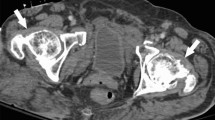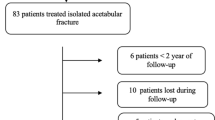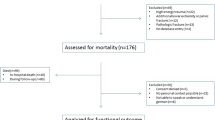Abstract
Purpose
Obesity is an epidemic which increases risk of many surgical procedures. Previous studies in spine and hip arthroplasty have shown that fat thickness measured on preoperative imaging may be as or more reliable in assessment of risk of post-operative infection and/or wound complications than body mass index (BMI). We hypothesized that, similarly, increased local fat thickness at the surgical site is a predictor of wound complication in acetabulum fracture surgery.
Methods
Patients who underwent open reduction and internal fixation (ORIF) of an acetabulum fracture through a Kocher-Langenbeck (K-L) approach at a single institution from 2013 to 2020 were identified. Pre-operative CT scans were used to measure fat thickness from the skin to the greater trochanter in line with the surgical approach. Post-operative infections and wound complications were recorded and associated with fat thickness and BMI.
Results
238 patients met inclusion criteria. 12 patients had either infection or a wound complication (5.0%). There was no significant association with BMI or preoperative fat thickness on post-operative infection or wound complication (p-value 0.73 and 0.86).
Conclusions
There is no statistically significant association of post-operative infection or wound complications in patients with increased soft tissue thickness or increased BMI. ORIF of acetabulum fractures through a K-L approach can be performed safely in patients with large subcutaneous fat thickness and high BMI with low risk of infection or wound complications.

Similar content being viewed by others
References
Hales CM, Carroll MD, Fryar CD, Ogden CL (2020) Prevalence of obesity and severe obesity among adults: United States. NCHS Data Brief 360:1–8
James PT, Leach R, Kalamara E, Shayeghi M (2001) The worldwide obesity epidemic. Obes Res 9(Suppl 4):228S-233S. https://doi.org/10.1038/oby.2001.123
Purcell KF, Bergin PF, Spitler CA, Graves ML, Russell GV (2018) Management of pelvic and acetabular fractures in the obese patient. Orthop Clin North Am 49:317–324. https://doi.org/10.1016/j.ocl.2018.02.005
Mittwede PN, Gibbs CM, Ahn J, Bergin PF, Tarkin IS (2021) Is obesity associated with an increased risk of complications after surgical management of acetabulum and pelvis fractures? a systematic review. J Am Acad Orthop Surg Glob Res Rev. https://doi.org/10.5435/JAAOSGlobal-D-21-00058
Shaath MK, Lim PK, Andrews R, Chip Routt ML (2020) Morbid obesity and short-term complications following acetabular fracture surgery: a comparative cohort study. Injury 51:2622–2627. https://doi.org/10.1016/j.injury.2020.08.021
Ding A, O’Toole RV, Castillo R, Reahl B, Montalvo R, Nascone JW et al (2018) Risk factors for early reoperation after operative treatment of acetabular fractures. J Orthop Trauma 32:251–257. https://doi.org/10.1097/BOT.0000000000001163
Robertson MJ, Lee RC, Bergin PF, Graves ML, Russell GV (2022) Complications of morbid obesity in the treatment of acetabular fractures: re-evaluating outcomes a decade later. J Orthop Trauma 36:87–92. https://doi.org/10.1097/BOT.0000000000002199
Porter SE, Russell GV, Dews RC, Qin Z, Woodall J, Graves ML (2008) Complications of acetabular fracture surgery in morbidly obese patients. J Orthop Trauma 22:589–594. https://doi.org/10.1097/BOT.0b013e318188d6c3
Mehta AI, Babu R, Sharma R, Karikari IO, Grunch BH, Owens TR et al (2013) Thickness of subcutaneous fat as a risk factor for infection in cervical spine fusion surgery. J Bone Joint Surg Am 95:323–328. https://doi.org/10.2106/JBJS.L.00225
Lee JJ, Odeh KI, Holcombe SA, Patel RD, Wang SC, Goulet JA et al (2016) Fat thickness as a risk factor for infection in lumbar spine surgery. Orthop 39:1124–1128. https://doi.org/10.3928/01477447-20160819-05
Watts CD, Houdek MT, Wagner ER, Taunton MJ (2016) Subcutaneous fat thickness is associated with early reoperation and infection after total knee arthroplasty in morbidly obese patients. J Arthroplast 31:1788–1791. https://doi.org/10.1016/j.arth.2016.02.008
Frenkel Rutenberg T, Markman R, Rutenberg R, Daglan E, Rubin T, Shemesh S (2022) Thickness of the subcutaneous fat as a risk factor for surgical site infection following fragility hip fracture surgery. Geriatr Orthop Surg Rehabil 13:21514593221080270. https://doi.org/10.1177/21514593221080272
Sagi HC, Dziadosz D, Mir H, Virani N, Olson C (2013) Obesity, leukocytosis, embolization, and injury severity increase the risk for deep postoperative wound infection after pelvic and acetabular surgery. J Orthop Trauma 27:6–10. https://doi.org/10.1097/BOT.0b013e31825cf382
Sems SA, Johnson M, Cole PA, Byrd CT, Templeman DC (2010) Minnesota orthopaedic trauma group. elevated body mass index increases early complications of surgical treatment of pelvic ring injuries. J Orthop Trauma 24:309–314. https://doi.org/10.1097/BOT.0b013e3181caa21e
Vincent HK, Haupt E, Tang S, Egwuatu A, Vlasak R, Horodyski M et al (2014) perioperative and acute care outcomes in morbidly obese patients with acetabular fractures at a level 1 trauma center. J Orthop 11:58–63. https://doi.org/10.1016/j.jor.2014.04.016
Lee M-J, Wu Y, Fried SK (2013) Adipose tissue heterogeneity: implication of depot differences in adipose tissue for obesity complications. Mol Aspects Med 34:1–11. https://doi.org/10.1016/j.mam.2012.10.001
Janssen I, Katzmarzyk PT, Ross R (2002) Body mass index, waist circumference, and health risk: evidence in support of current national institutes of health guidelines. Arch Intern Med 162:2074–2079. https://doi.org/10.1001/archinte.162.18.2074
Dalton M, Cameron AJ, Zimmet PZ, Shaw JE, Jolley D, Dunstan DW et al (2003) Waist circumference, waist-hip ratio and body mass index and their correlation with cardiovascular disease risk factors in australian adults. J Intern Med 254:555–563. https://doi.org/10.1111/j.1365-2796.2003.01229.x
Jaeblon T, Perry KJ, Kufera JA (2018) Waist-hip ratio surrogate is more predictive than body mass index of wound complications after pelvic and acetabulum surgery. J Orthop Trauma 32:167–173. https://doi.org/10.1097/BOT.0000000000001102
Avilucea FR, Ferreira R, Shaath MK, Haidukewych GJ (2024) Opportunistic use of computed tomography to determine muscle-adipose ratio reliably predicts wound complications after kocher-langenbeck surgical exposure of the acetabulum. J Orthop Trauma 38:31. https://doi.org/10.1097/BOT.0000000000002676
Funding
No external funding was used in this study.
Author information
Authors and Affiliations
Corresponding author
Ethics declarations
Conflict of interest
Jack Weick reports the following: Orthopaedic Trauma Association, board or committee member. Jonathan Eastman reports the following: AO North America, board or committee member; Globus Medical, paid consultant; Osteocentric, IP royalties; Stryker, paid consultant. Milton L. Chip Routt reports the following: AO North America, board or committee member, paid presenter or speaker; Johnson & Johnson, paid presenter or speaker; Stryker, paid presenter or speaker; Zimmer, paid presenter or speaker. Stephen Warner reports the following: AAOS, board or committee member; AO North America, board or committee member; Globus Medical, paid consultant, paid presenter or speaker; Orthopaedic Trauma Association, board or committee member; Smith & Nephew, paid presenter or speaker; Stryker, paid consultant, paid presenter or speaker. Remainder of authors have nothing to disclose.
Ethical approval
All procedures performed in studies involving human participants were in accordance with the ethical standards of the institutional and/or national research committee and with the 1964 Helsinki declaration and its later amendments or comparable ethical standards.
Additional information
Publisher's Note
Springer Nature remains neutral with regard to jurisdictional claims in published maps and institutional affiliations.
Rights and permissions
Springer Nature or its licensor (e.g. a society or other partner) holds exclusive rights to this article under a publishing agreement with the author(s) or other rightsholder(s); author self-archiving of the accepted manuscript version of this article is solely governed by the terms of such publishing agreement and applicable law.
About this article
Cite this article
Weick, J.W., Svetgoff, R.A., Obey, M.R. et al. Does local fat thickness correlate with post-operative infection in open reduction and internal fixation of acetabulum fractures?. Eur J Orthop Surg Traumatol 34, 2049–2054 (2024). https://doi.org/10.1007/s00590-024-03892-z
Received:
Accepted:
Published:
Issue Date:
DOI: https://doi.org/10.1007/s00590-024-03892-z




